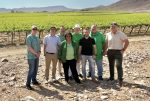Tin producer Andrada Mining, which over the past several years has brought the historic Uis tin mine in Namibia back to life, is in the process of adding both lithium and tantalum to its product lineup.
As Andrada CEO, Anthony Viljoen, recently explained that Andrada now identifies as a polymetallic producer focused on providing the ‘technology metals’ required as the world transitions to a greener future.
Located 230 km north of Walvis Bay in Namibia’s Erongo Region, Uis was acquired by AIM-listed Andrada (or AfriTin, as it was then) in 2017. At that point, Andrada was only interested in the project’s tin potential and had not yet realised that it offered considerable upside in the form of lithium and tantalum. As Viljoen says, “AfriTin was a pure tin play and other metals were not on our radar back then.”
Although the Uis tin mine mineralisation was discovered in 1911, it was only in the early 1950s that a commercial scale mine was established at the site. This was acquired by Iscor – through its subsidiary, Imcor – in the late 1950s. Mining continued through to 1990 when the tin price collapsed, and the mine was closed. During its years of operation, Uis tin mine ranked as the largest hard-rock tin mine in the world, with an annual production of 1 500 tonnes of tin. This is modest by modern standards but was considerable by the standards of the day back then.
“When we came on site, Uis was an abandoned mine,” Viljoen recalls. “It was not even on care and maintenance – literally everything had been stripped. When Iscor left, the local village, numbering about 3 000 people, was devastated as there were no alternative employment opportunities in the area. We now employ around 500 people, including contractors, with about 38% recruited from the Erongo region.”
Lithium and tantalum resources at Uis tin mine
He says that the exploitation of the lithium and tantalum resources will make Uis, already a healthy operation, healthier still. “The polymetallic nature of our deposits basically means we’re able to get three products for the price of one. They’re all in the same ore body. You could say that we’re going to end up producing either the tin for free or the lithium and tantalum for free.”
Viljoen, who has a background in finance, has a long history of entrepreneurship in the mining field and his past ventures have included Lemur Resources and Bushveld Minerals. While not a geologist or mining engineer himself, his father is renowned geologist Richard Viljoen while his late uncle, Morris Viljoen, was an equally distinguished geologist. Richard and Morris, who were twins, contributed much to the geological understanding of Uis at the time Viljoen was assessing the asset.
The Uis mining licence covers a swarm of more than 180 pegmatites although historically only 12 of these were mined. Andrada has so far focused on the V1/V2 pegmatites, which were mined in the Iscor days. It declared a Maiden Resource Estimate (MRE) for V1/V2 in 2019 of 71.54 Mt at a grade of 0.134% tin for 95.54 kt of contained tin. This was based on 141 historical drill holes and 26 confirmatory holes drilled by Andrada in 2019.
This MRE provided Andrada for the first time with an insight into the lithium/tantalum potential at Uis, revealing that V1/V2 also contained just over 6 kt of tantalum and 450 kt of lithium oxide (Li2O). As Viljoen points out, the historical data and assays did not typically capture these elements, as there was no significant demand for them at the time Iscor was mining.
Andrada announced earlier this year an expansion of the tin resource. It declared a revised MRE for what are known as the ‘Proximal Pegmatites’. These are the 11 historically mined pegmatites that are close to V1/V2, all within a 3 km radius of the plant. According to the MRE, these host a further 57.18 Mt containing 74.86 kt of tin.
Phased development at Uis tin mine
Reflecting the fact that it started as a junior with limited resources, Andrada has developed Uis in a phased manner, starting small to generate cashflows and progressively expanding its mining and production footprint. A pilot plant was established in 2019, which over the next few months ramped up to a production level of 60 tonnes of tin concentrate a month.
The plant was based on a similar gravity flowsheet to that used by Iscor with the difference that Andrada elected to use DMS units rather than jigs. The first concentrate was produced in August 2019 and in February 2020 Andrada was able to export its first concentrate to its offtake partner, Thailand Smelting and Refining Company.
Once the pilot plant was ramped up, Andrada embarked on an expansion of the facility and the execution phase started in September 2021 with the ordering of long-lead items. The Phase 1 expansion, as it is known, was completed roughly a year later and commissioning took place in October 2022.
Modular expansion of the pilot plant
The project involved a modular expansion of the pilot plant and included an expansion of the crushing and screening circuits (the ‘dry plant’), the construction of a fines ore stockpile prior to the concentrator and the upgrade of the concentrator cleaning circuit, as well as upgrades to the process control and instrumentation. It takes the capacity of the plant up to 1 200 tonnes per annum (tpa) of tin concentrate. Further expansion is on the cards.
“We can expand by about 300% using our existing infrastructure footprint,” says Viljoen. “Our resource, however, is big enough to allow an operation roughly ten times the size of what we are currently doing.”
Andrada released the results of a PEA on the proposed Phase 2 expansion in April last year. If implemented, this would take the ore throughput up to 10 Mtpa (compared to about 1 Mtpa currently) and result in a yearly production of 15 kt of tin concentrate (9 kt of contained tin), 1 kt of tantalum concentrate (200 tonnes of contained Ta2O5) and 450 kt of 4 % lithium petalite concentrate (18 kt of contained Li2O). The projected capex is a substantial US$440 million but the project has an after-tax NPV (8%) of US$2.1 billion and an IRR of 75%.
The current mining operation at Uis is a straightforward load-and-haul operation using articulated haulers and excavators in the 40-tonne capacity range. The mining contractor is Nexus, a Namibian construction group. With Uis having a low grade, the volumes are sizeable for what is still a relatively low level of tin production. “Our operation is all about moving as much tonnage as we can as efficiently as possible,” says Viljoen.
Production of first saleable lithium concentrate
Andrada produced it first saleable lithium concentrate through an offsite pilot test programme earlier this year. Lithium concentrate production is now starting to move to a new level, as the company has just completed the construction – and is commissioning – a lithium bulk sampling plant on site, as well as a tantalum production circuit. The lithium plant consists of crushing and screening equipment, a DMS module and a gravity separation circuit.
It has a throughput capacity of 20 tonnes per hour (tph) with minimum annual production targeted at 2.4 kt and potentially an upper annual production target of 10 kt. It is intended that a pilot lithium flotation and sensor-based sorting circuit will be added in the near future to provide additional optionality in the treatment of lithium ores.
Andrada believes the lithium plant can potentially generate annual early revenues of between US$5 million and US$20 million a year at the upper levels of production assuming an average grade of 4.0% Li2O and an average petalite price of US$2 000 per tonne.
The mining licence Andrada has over the Uis property (ML134) is just one of three that Andrada holds, the others being Nai Nais/Lithium Ridge ((ML133) and B1C1/Spodumene Hill (ML129). Additionally, the company has an exploration licence covering an area known as Brandberg West, which lies about 100 km to the west of Uis, which is prospective for tin, copper and tungsten.
Andrada is planning to bring all these properties into the mix in the course of time and has set a mineral resource target of 200 Mt to be delineated within the next five years. In pursuit of this target, an inaugural drill programme was recently undertaken over the B1 and C1 pegmatites at Spodumene Hill. All drill holes intersected mineralised pegmatites, indicating continuity at depth.
“The drill results provide an initial glimpse into the potential of what we are now calling the Spodumene Hill project,” says Viljoen. “The identified high-grade lithium intersections within the pegmatite could be separated through ore sorting to provide potentially high-grade pre-concentrate for our lithium plant.”
With the Uis tin plant now running at its Phase 1 capacity and the addition of the lithium and tantalum circuits, 2023 is shaping up to be a transformational year for Andrada, which has now invested the best part of R1 billion in Namibia.
“We’ve established ourselves as a producer of a range of tech metals,” says Viljoen. “Our lithium initiative is particularly exciting as lithium is in a bull market the likes of which I’ve never seen in all my years in mining. There’s just not enough readily available material to meet demand.” He adds that Andrada has embarked on a process to find a strategic partner in the lithium space.
Outlook
Looking ahead, Viljoen says the outlook for Andrada is very promising. “The tin price is likely to remain buoyant for the next several years and is well in excess of our C1 cost of production of about US$1 500 per tonne. Add to this the extra revenue we’ll soon be deriving from lithium, and you have a very healthy company. In addition, we can easily expand our processing facilities and bring additional resources beyond V1/V2 into production when required so our future growth is secured. In short, the prospects for Andrada have never looked better.”
This article was originally written by Arthur Tassell for Mining Review










